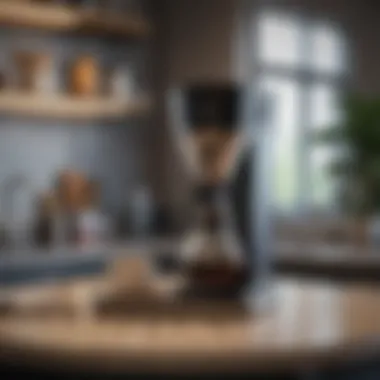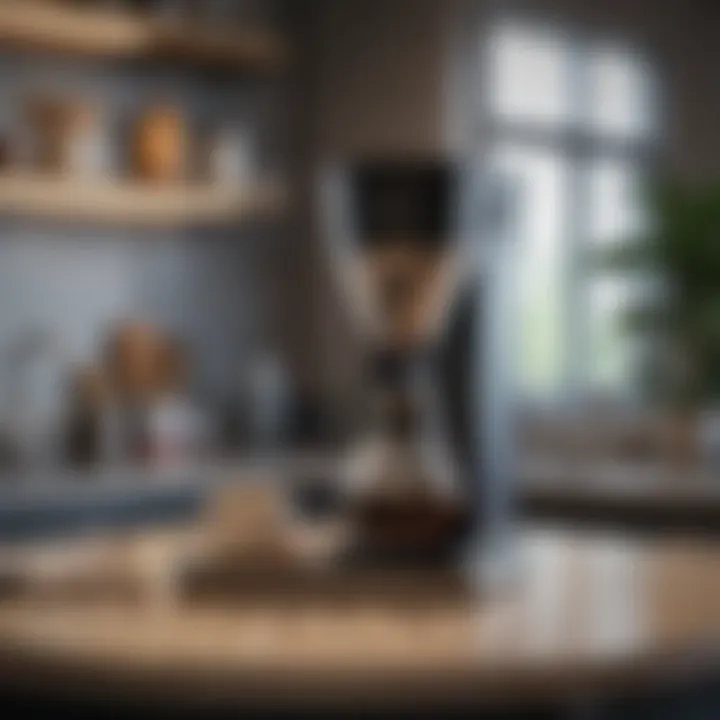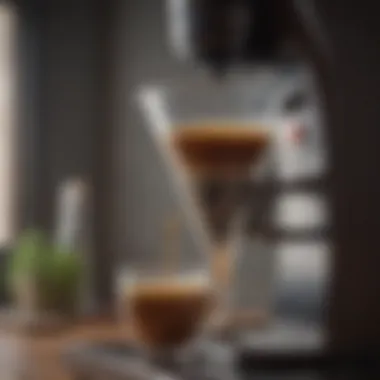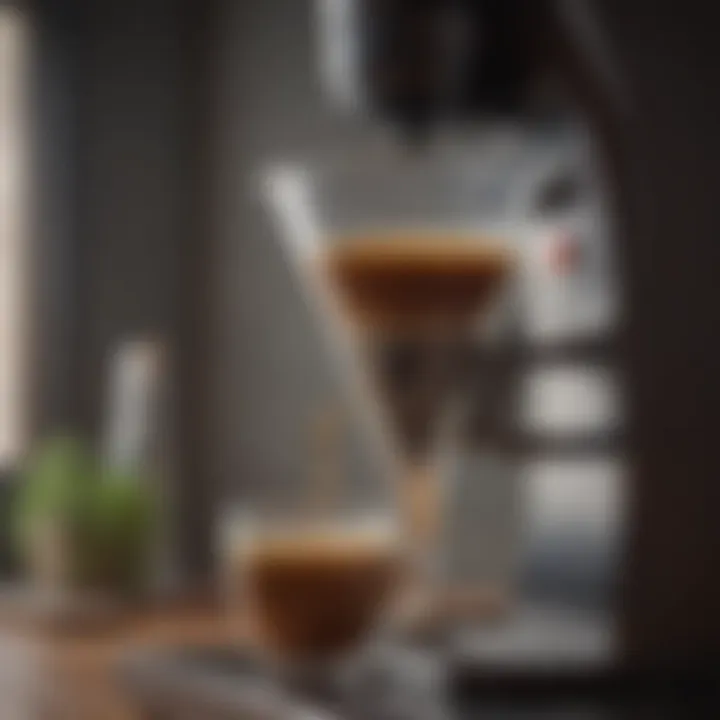Exploring the Beauty and Functionality of Pour Over Coffee Makers


Intro
Pour over coffee has transcended mere beverage preparation to become an art form in its own right. For design-conscious consumers, beautiful pour over coffee makers serve as both functional tools and striking pieces of decor. This exploration will delve into fascinating aspects of these coffee makers, including design inspirations, trending styles, maintenance, and their role in modern kitchen aesthetics.
Design Inspiration
Trending Styles
In recent years, the popularity of pour over coffee has led to a diverse array of styles in coffee makers. Each design reflects a different aesthetic vision while enhancing the brewing experience. Here are some notable trends:
- Minimalist Designs: Brands such as Hario and Kalita have embraced simplicity. Their clean shapes and understated colors help create an uncluttered workspace.
- Craftsmanship: Exceptional items come from artisans crafting unique designs, incorporating materials like hand-blown glass or clay. These makers offer pieces that are both functional and a conversation starter.
- Retro Looks: Vintage-inspired designs evoke nostalgia. They often feature bold colors and geometric shapes reminiscent of mid-century modern furniture, appealing to fans of that era.
Color Palettes
The color of a pour over coffee maker can significantly affect its presentation in a kitchen. Popular color options include:
- Soft Neutrals: Shades like white, beige, or gray complement various kitchen styles without overwhelming them. These can blend seamlessly into modern interior decor.
- Bold Hues: Vibrant colors such as cobalt blue or deep red can serve as focal points. They catch the eye and create excitement in the kitchen space.
- Natural Tones: Many designs incorporate earthy colors, aligning with sustainable trends. Materials like bamboo or unglazed ceramics reflect a more organic, calming approach.
Practical Tips
To optimize both aesthetics and functionality when selecting a pour over coffee maker, consider the following:
Maintenance & Care
Maintaining the beauty of your coffee maker is essential. Here are effective tips:
- Regular Cleaning: Rinse the coffee maker after each use. Deep clean it at least once a week with vinegar or a specialized cleaner to prevent coffee oils from accumulating.
- Avoid Harsh Chemicals: Use warm soapy water instead of abrasive scrubs, which may scratch delicate surfaces.
- Store Properly: Keep it in a dry space, and avoid stacking other kitchen items on top to prevent chipping or breakage.
Budgeting & Planning
Investing in a high-quality pour over coffee maker can elevate everyday brewing into an exceptional experience. However, budget considerations are important. Factors to keep in mind include:
- Material: Glass and ceramic may be pricier but offer superior aesthetics and durability compared to plastic options.
- Brand Reputation: Established brands like Chemex or Bonavita come with a cost but often guarantee longevity and performance.
- Multi-Functionality: Some models serve as stylish decor while being highly functional. Investing in these can enhance your kitchen’s overall appeal.
Integrating functionality and beauty in pour over coffee makers elevates both the brewing process and kitchen design.
By understanding the nuances of design and function, homeowners and design enthusiasts can find the perfect pour over coffee maker that complements their lifestyle and aesthetic preferences. A well-chosen coffee maker will not only brew a superior cup of coffee but become a centerpiece in culinary creativity.
Prolusion to Pour Over Coffee
Pour over coffee stands as a unique method in the realm of coffee brewing, renowned for its ability to provide a careful, hands-on coffee experience. The beauty of this technique is not merely in the taste of the coffee produced, but also in the artistry of the brewing process itself. Unlike automatic coffee makers, the pour over method allows for a greater degree of control over various parameters such as water temperature and pour rate. This has significant implications for both the flavor profile of the coffee and the enjoyment of the brewing ritual.
The pour over technique has attracted attention from design-conscious consumers, who appreciate the aesthetics of beautiful coffee makers. These devices add an element of style to the kitchen, often acting as a focal point during gatherings or daily routines. The significance of the topic lies in understanding how aesthetics and functionality can come together in perfect harmony. By exploring the merits of pour over coffee, we can gain insights into why many enthusiasts prefer this method.
The History of Coffee Brewing Methods
The methods for brewing coffee have evolved dramatically over the centuries, moving from rudimentary techniques to the sophisticated mechanisms we see today. Early coffee brewing methods, such as the boiling of ground beans in water, lacked precision and control. The introduction of various brewing devices over time—from the French press to espresso machines—transformed how coffee is enjoyed.
The pour over method emerged as a response to the desire for more control, both in terms of flavor extraction and presentation. This evolution underscored a significant shift towards appreciating the sensory experience of coffee drinking, focusing on aroma and taste.
The Rise of the Pour Over Technique
In recent years, the pour over coffee technique has gained popularity, becoming an emblem of the specialty coffee movement. This resurgence reflects not only a shift in preference but also a cultural appreciation for craftsmanship. Enthusiasts are drawn to the tactile nature of the process and its intimate connection to the end product.
Baristas and home brewers alike have adopted various techniques, each adding to the coffee’s complexity. Factors such as the type of grinder used, the origin of the coffee beans, and the water quality play pivotal roles in determining the outcome. The pour over method encourages experimentation, allowing individuals to discover their ideal brew.


In summary, the pour over coffee method blends tradition with modernity. It invites the drinker to engage not just with the beverage itself but also with the act of making it. This section sets the stage for deeper exploration into the specific characteristics of beautiful pour over coffee makers.
Defining Beautiful Pour Over Coffee Makers
The concept of beautiful pour over coffee makers revolves around both aesthetics and practical usability. As consumers increasingly seek items that not only perform well but also enhance their surroundings, the importance of defining what makes a coffee maker beautiful becomes vital. This section will explore various facets that contribute to the allure of these devices, from visual design to the materials used in their construction.
Aesthetic Considerations
Aesthetics play a crucial role in the choice of kitchen appliances, particularly for pour over coffee makers. The visual appeal of a coffee maker can transform a mundane brewing process into an elevated experience. From elegant curves to striking geometric shapes, each design aspect can influence the overall ambiance of a space.
When selecting a pour over coffee maker, consider:
- Color and Finish: Different colors and surface finishes offer varied impacts on kitchen decor. Matte black or polished stainless steel can appeal to minimalistic designs, while vibrant hues may add a playful touch.
- Design Harmony: How well does the coffee maker integrate with existing kitchen elements? A cohesive look is essential; mismatched designs can disrupt visual flow.
- Size and Scale: The dimensions of the coffee maker should align with counter space. A compact model may suit smaller kitchens, whereas a grand design can serve as a statement piece in larger areas.
The harmony between function and form results in a device that is not only useful but also an attractive addition to any kitchen.
Material Choices and Their Impact
Material selection significantly affects both function and aesthetic appeal in pour over coffee makers. Each material brings its own set of qualities that can enhance or detract from the overall coffee brewing experience. Understanding these can help guide potential buyers.
- Ceramics: Often used for their ability to retain heat well, ceramic pour over devices provide a classic look. Their unique glazes also introduce texture and color, making them visually appealing.
- Glass: This material allows users to visually engage with the coffee brewing process. Glass vessels can showcase the brewing color and movement of coffee, adding an artistic element.
- Stainless Steel: Known for durability and modern aesthetics, stainless steel coffee makers resist stains and are easy to clean. Their sleek appearance suits contemporary kitchen design while providing excellent heat retention.
- Plastic: Typically lightweight and affordable, plastic versions can be practical, though their look may not appeal to design-focused consumers. However, advancements in design have improved some plastic models, making them visually engaging as well.
Choosing the right material can enhance the brewing experience, making it as much about the process as the final product.
Types of Pour Over Coffee Makers
The selection of a pour over coffee maker is crucial for both aesthetic appeal and functionality. Various types offer different brewing experiences and results. Understanding these types helps consumers make informed choices that align with their personal style and desired coffee characteristics.
Ceramic Pour Over Makers
Ceramic pour over makers are renowned for their durability and thermal retention. Their dense material helps maintain steady heat, which is essential for optimal extraction. Additionally, ceramic offers a variety of colors and designs, making them visually pleasing and a great fit for many kitchens.
However, one should handle them cautiously since they can crack or chip if dropped. It is important to wash them carefully to prevent wear. They often feature unique shapes that can enhance the brewing process, leading to flavorful outcomes. The combination of form and function makes ceramic pour over makers an elegant choice.
Glass Pour Over Devices
Glass pour over devices, such as the Hario V60, are appreciated for their aesthetic clarity. These makers allow users to observe the brewing process, offering a visual delight.
Glass is non-porous, which means it does not absorb flavors from previous brews, giving each cup a pure taste. A potential downside is fragility; they require careful handling and storage. Their lightweight nature also means that they can get hot during use, so caution is necessary to avoid burns. Nonetheless, many enthusiasts prefer glass for its clean design and the ability to see the extraction in progress.
Stainless Steel Options
Stainless steel pour over makers provide a modern touch to coffee brewing. They are known for their sturdiness and resistance to corrosion. This material is easy to clean and often dishwasher-safe. Many stainless steel options also come with double-walled construction, preserving heat more effectively than other materials.
A notable aspect of stainless steel makers is the variety of designs available, from sleek and minimalist to more ornate shapes. They do not shatter upon contact, allowing them to be more rugged for outdoor or travel use. However, they can sometimes influence the taste slightly, so finding a high-quality option is advisable.
Plastic Pour Over Systems
Plastic pour over systems are often the most economical choice for coffee lovers. They are lightweight, making them portable and easy to store. Additionally, they come in various colors and designs, catering to a wider audience.
Despite their low price point, high-quality plastic options can still provide excellent brewing results. The downside is that they may not retain heat as well as ceramic or glass, which can slightly affect the tasting experience. Moreover, some plastic can absorb odors over time, so regular cleaning is necessary to maintain purity.
In summary, each type of pour over coffee maker has its unique benefits and drawbacks. When selecting a maker, consider aesthetic appeal, material durability, and how each device influences the coffee brewing experience. This way, one can enjoy not only a great cup of coffee but also a beautiful addition to the kitchen.
The Brewing Process
The brewing process is a crucial aspect of making pour over coffee. It involves several specific elements that significantly influence the flavors and overall quality of the coffee. Understanding these factors can enhance the experience for both novice and experienced coffee makers. The way one brews coffee affects not only the taste but also the aesthetic presentation. This section outlines the key components of the brewing process, emphasizing their importance.


Selecting the Right Coffee Beans
Choosing the right coffee beans is foundational to a successful pour over brew. The beans' origin, roast level, and freshness will determine the character of the coffee. Single-origin beans are often favored for their distinct flavors, while blends provide complexity. Opting for freshly roasted beans is essential, as stale beans can lead to a dull cup. Look for beans dated within two weeks of roasting to ensure optimal flavor. Additionally, consider the variety and processing methods, as these can further enhance the unique notes in your brew.
Understanding Grind Size
Grind size plays a pivotal role in extraction during the brewing process. For pour over coffee, a medium-coarse grind is usually recommended. If the grind is too fine, it may result in over-extraction, leading to bitterness. Conversely, a grind that is overly coarse can cause under-extraction, resulting in a weak flavor. To achieve a balanced cup, consistency in grind size is essential. Investing in a quality burr grinder can help in achieving the right texture for pour over brewing.
Water Temperature and Quality
Both water temperature and quality are critical for optimum extraction. Generally, the ideal water temperature for brewing pour over coffee ranges from 197°F to 205°F (92°C to 96°C). Water that is too hot can scorch the coffee, while too cool water fails to extract the full flavor profile. Additionally, the quality of the water impacts the brew. Using filtered water free from impurities ensures that the true taste of the coffee shines through. High mineral content in water can enhance flavors, but it’s essential not to overdo it.
Pouring Techniques
Mastering pouring techniques can significantly influence the brewing outcome. The goal is to saturate the coffee grounds evenly for optimal extraction. A slow, circular pouring motion is often recommended to ensure that all coffee grounds receive water uniformly. Starting at the center and moving outward is a common practice. Timing also matters; allowing the coffee to bloom for about 30 seconds before continuing to pour enhances flavor development. Practice different techniques to find the one that yields the best results for your desired taste profile.
The brewing process in pour over coffee is not merely a routine; it is an art form that melds precise techniques with quality ingredients to produce a rewarding cup.
By understanding and mastering these elements of the brewing process, one can transform a simple activity into a unique and fulfilling experience. The interplay of quality coffee beans, correct grind size, precise water temperature, and skilled pouring creates a brew that is not just functional but beautiful.
The Impact of Design on User Experience
The design of pour over coffee makers plays a crucial role in the user experience. It encompasses everything from the ergonomics of handling the device to aesthetic qualities that enhance the overall enjoyment of the brewing process. When homeowners or design enthusiasts select a coffee maker, they seek more than just functionality; they want an object that resonates with their style while providing a quality brew. This section will explore how design influences usability and visual satisfaction.
Ergonomics in Pour Over Design
When discussing ergonomics in pour over design, this refers to the product’s usability and how effectively it aligns with a user’s physical capabilities. A well-designed pour over device ensures that users can handle and operate it with ease. Features such as spouts, handles, and weight distribution are key elements to consider.
- Comfortable Grip: A handle that fits comfortably in a user’s hand is vital. If it is not comfortable, pouring hot water can become a burden rather than an enjoyable activity.
- Optimal Pouring Angle: The spout design can affect how water is poured. A well-crafted spout allows for a controlled flow, which is significant for achieving the ideal brew.
- Material Weight: Lightweight materials may seem appealing, but heaviness often translates to stability, especially during pouring. Therefore, the balance between weight and ease of use should never be overlooked.
These ergonomic considerations contribute to a seamless brewing experience. A pour over coffee maker should feel natural and intuitive. For instance, the Hario V60 and Chemex both exemplify ergonomic designs that accommodate user comfort while promoting quality coffee extraction.
Visual Appeal and Kitchen Decor
Visual appeal directly impacts how users perceive their kitchen environment. A coffee maker that doubles as a design piece becomes more than just a functional tool. It can enhance kitchen aesthetics and often reflects the personality of the owner.
- Harmonizing Colors: The color palette of a coffee maker can either blend into a kitchen or stand out as a statement piece. For homeowners with a minimalist design, a clean white ceramic pour over may suit their decor, while a bold, colorful model might attract those who embrace vibrance.
- Showcase Design: Some pour over coffee makers are pure art. Devices like the Moccamaster not only brew coffee but also serve as focal points on countertops. Their elegant lines and polished finishes align with contemporary design trends.
- Functionality Reflected in Design: Beautiful designs often reflect the maker's functionality. For example, the simplicity of the Bodum pour over brewer visually represents the straightforward approach to brewing processes.
Ultimately, a beautiful pour over coffee maker can be an essential component of kitchen decor. It contributes to the ambiance while offering an invitation to engage in a ritual that many coffee lovers cherish.
In summary, the impact of design on user experience is profound. It encompasses how the product feels to use, how it conveys aesthetic values, and how it enhances the overall experience of preparing coffee in a stylish manner.
Maintenance and Care for Pour Over Coffee Makers
Maintaining and caring for pour over coffee makers is essential for both their longevity and your overall coffee experience. These devices, while beautiful, also require proper attention to function at their best. Regular cleaning and thoughtful storage ensure that your coffee maker continues to produce quality brews and remains an attractive piece in your kitchen.
Effective maintenance practices can significantly enhance the flavor and aroma of your coffee. As residues from coffee oils and minerals accumulate, they can alter the taste of future brews. Thus, cleaning your pour over coffee maker is not just a routine task; it is a fundamental requirement for preserving the integrity of your coffee.
Additionally, caring for your coffee maker also reflects your appreciation for the craftsmanship that goes into these beautiful devices. A well-maintained coffee maker adds to the aesthetic of your kitchen, contributing to a space that celebrates the art of coffee brewing.
Cleaning Techniques for Various Materials
Different pour over coffee makers come in a variety of materials, including ceramic, glass, stainless steel, and plastic. Each material has unique cleaning needs that, when fulfilled, can ensure the device's durability and maintain its appearance.
- Ceramic Pour Over Makers: For ceramic, gentle hand washing is preferred. Use warm water and mild dish soap. Avoid harsh abrasives to prevent scratches and cracks. After cleaning, let it air dry completely.
- Glass Pour Over Devices: Glass is delicate and can break easily. Clean glass coffee makers with a gentle sponge and lukewarm soapy water. Rinse thoroughly to avoid residue. Many glass devices are also dishwasher safe, but it's best to check manufacturers’ guidelines.
- Stainless Steel Options: For stainless steel, you can use baking soda for tougher stains. A mixture of baking soda and water can work effectively without scratching the surface. Wipe it down with a soft cloth to keep it looking shiny.
- Plastic Pour Over Systems: Plastic can be prone to scratching and retaining odors. Clean with mild soap and a soft sponge. Some plastic devices can tolerate the top rack of the dishwasher, but always confirm with the manufacturer's instructions.
"Regular cleaning of your pour over coffee maker is crucial to ensure the best flavor and quality in every cup."


Storage Recommendations
Proper storage is vital to extend the life of your pour over coffee maker. Storing the device correctly can protect it from damage or contamination.
- Keep it Dry: Always store your coffee maker in a dry place. Moisture can encourage mold growth, especially in plastic devices.
- Avoid Direct Sunlight: Prolonged exposure to direct sunlight can fade colors and degrade materials, especially plastic and ceramic. Choose a shaded area for storage.
- Separate from Other Kitchen Items: If possible, store your pour over coffee maker separate from other cooking or kitchen items to avoid accidental damage.
- Use a Display Case: If the aesthetic appeal of your coffee maker is one of its main attractions, consider using a display case. This can protect it while also showcasing its beauty to guests.
Taking these small but significant steps can ensure that your pour over coffee maker remains in excellent condition, ready to deliver delightful brews. By investing time into maintenance and care, you uphold both the functionality and the visual charm of your coffee maker.
Choosing the Right Pour Over Coffee Maker for Your Needs
Selecting the right pour over coffee maker is essential for both aesthetics and functionality. With a plethora of options available, understanding what factors matter most can significantly enhance the drinking experience. Making an informed choice ensures that the coffee maker aligns with personal preferences while also complementing kitchen decor. This decision can affect flavor extraction, ease of use, and even the overall enjoyment of the brewing ritual. Therefore, it becomes paramount to consider various elements in making the best selection.
Factors to Consider When Buying
When it comes to choosing a pour over coffee maker, several factors should guide your decision:
- Size and Capacity: Depending on how much coffee you typically brew, size matters. A compact model might suit an individual or small household, while larger options serve well for entertaining guests.
- Material: Different materials impact not only aesthetics but also durability and heat retention. Ceramic and glass models are beautiful but may require careful handling. Stainless steel can offer longevity and ease of cleaning.
- Design Style: Whether you prefer a modern, minimalist look or a more classic design, the appearance of the coffee maker should resonate with your taste and kitchen design.
- Brewing Control: Some models allow greater control over brewing variables like water temperature and pour rate. These features may appeal to those who value precision in their coffee-making process.
- Ease of Cleaning: Maintenance is vital in keeping a coffee maker functional and attractive. Consider how easy it is to clean the chosen model, particularly if you brew often.
Comparing Popular Models
In the marketplace, several models stand out due to their unique features and aesthetic appeal. Here are a few well-regarded options:
- Hario V60: This model is known for its cone-shaped design, enabling precise water distribution. Available in ceramic, glass, and plastic, it offers versatility in choices.
- Chemex: The Chemex features an elegant hourglass shape made from glass, appealing to those who value design. Its thick paper filters produce a clean cup of coffee, emphasizing clarity of flavor.
- Kalita Wave: This model is celebrated for its flat-bottom design, promoting even extraction. It is suitable for users looking for ease and consistency in brewing.
- Bonavita Immersion Dripper: Combining immersion brewing with pour-over methods, it simplifies the process and produces a rich cup.
"The best pour over coffee makers not only brew great coffee but also enhance the kitchen's overall design."
When assessing these models, users must think about their brewing needs and aesthetic preferences. Taking time to research and compare different options can lead to a more satisfying purchase experience.
The Cultural Significance of Coffee Drinking
Coffee has a long and intricate history that transcends mere consumption. It is a drink that fosters connections, serves as a backdrop for conversations, and even creates communities. Understanding the cultural significance of coffee drinking is essential to appreciate why devices like pour over coffee makers have found a place in modern homes and cafés.
Coffee as a Social Activity
Coffee has often served as a catalyst for social interactions. Whether it is a morning ritual or an afternoon break, the act of brewing coffee often brings individuals together. For many, sharing a cup of coffee can strengthen friendships and familial bonds. The pour over coffee method, with its attendant rituals, becomes a shared experience.
Pour over brewing involves specific techniques and often requires attention to detail. This attention can lead to greater appreciation of the drink, inviting people to explore flavors more deeply. Many people gather around the brewing process, asking questions or participating in the experience.
This social dimension is not just about the beverage itself; it's about the connections formed during the experience.
"Coffee has the power to transform a casual meet-up into a meaningful interaction."
Pour Over Coffee in Modern Cafés
Modern cafés have adopted pour over coffee as not just a method of preparation but also as a hallmark of quality. In this setting, the pour over method becomes a spectacle, turning coffee-making into a performance. Baristas often take center stage, showcasing their skill in front of captivated patrons. The aesthetics of the pour over process contribute to an elevated café experience, aligning well with the growing trend of artisanal, hand-crafted products.
Many cafés now highlight their pour over options on menus, often showcasing the unique origins of the beans used. This practice allows for greater storytelling around each cup, encouraging customers to appreciate not only the drink but also its provenance.
This cultural inclination towards artisanal methods is significant in today's society. Consumers increasingly desire an experience that goes beyond convenience. The act of drinking coffee becomes not just about caffeine intake but rather an exploration of taste, process, and even philosophy.
In summary, the cultural significance of coffee drinking extends well beyond a simple beverage. With the pour over coffee maker becoming a focal point, both at home and in cafés, it has transformed how people view coffee. It is a medium that combines aesthetics with functionality, enriching connections in various social settings.
The End: The Intersection of Aesthetics and Functionality
The exploration of pour over coffee makers reveals a significant relationship between aesthetics and functionality. Beautiful pour over coffee makers are not merely tools for brewing coffee; they are also design elements that enhance kitchen spaces. Their striking design attracts the attention of homeowners, interior designers, and coffee aficionados alike, making them integral to modern kitchens.
Final Thoughts on Beautiful Pour Over Coffee Makers
Beautiful pour over coffee makers represent a blend of practical utility and artistic expression. They elevate the coffee brewing experience while also serving as a statement piece in home decor. Considerations such as material, shape, and color impact not only the aesthetic appeal but also the brewing capabilities.
- Design Influence: A well-designed pour over coffee maker should not only look good on the countertop but function effectively to produce quality coffee. The design must allow for ease of use while enhancing the sensory experience of brewing.
- User Preference: Many consumers appreciate the art that comes with pour over coffee preparation. The ability to control each step of the brewing process contributes to a unique coffee experience, emphasizing both craftsmanship and enjoyment in the daily ritual of coffee brewing.
- Enhanced Experience: The beauty of these coffee makers lies in their ability to transform a simple act into a moment of pleasure. When aesthetics meet functionality, the kitchen becomes a place where household tasks are appreciated for their beauty and efficiency.
In summary, investing in a beautiful pour over coffee maker is not just about aesthetics; it is about enhancing the overall coffee experience. Those who appreciate the art of coffee brewing find joy in items that combine elegance with practicality. By selecting a product that harmonizes design with performance, one can enrich their coffee drinking rituals while simultaneously uplifting the visual appeal of the kitchen.















